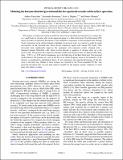Modeling the horizon-absorbed gravitational flux for equatorial-circular orbits in Kerr spacetime
Author(s)
Taracchini, Andrea; Buonanno, Alessandra; Khanna, Gaurav; Hughes, Scott A
DownloadTaracchini_Modeling-the-horizon-absorbed.pdf (1.473Mb)
PUBLISHER_POLICY
Publisher Policy
Article is made available in accordance with the publisher's policy and may be subject to US copyright law. Please refer to the publisher's site for terms of use.
Terms of use
Metadata
Show full item recordAbstract
We propose an improved analytical model for the horizon-absorbed gravitational-wave energy flux of a small body in circular orbit in the equatorial plane of a Kerr black hole. Post-Newtonian (PN) theory provides an analytical description of the multipolar components of the absorption flux through Taylor expansions in the orbital frequency. Building on previous work, we construct a mode-by-mode factorization of the absorbed flux whose Taylor expansion agrees with current PN results. This factorized form significantly improves the agreement with numerical results obtained with a frequency-domain Teukolsky code, which evolves through a sequence of circular orbits up to the photon orbit. We perform the comparison between model and numerical data for dimensionless Kerr spins -0.99≤q≤0.99 and for frequencies up to the light ring of the Kerr black hole. Our proposed model enforces the presence of a zero in the flux at an orbital frequency equal to the frequency of the horizon, as predicted by perturbation theory. It also reproduces the expected divergence of the flux close to the light ring. Neither of these features are captured by the Taylor-expanded PN flux. Our proposed absorption flux can also help improve models for the inspiral, merger, ringdown of small mass-ratio binary systems.
Date issued
2013-08Department
Massachusetts Institute of Technology. Department of Physics; MIT Kavli Institute for Astrophysics and Space ResearchJournal
Physical Review D
Publisher
American Physical Society
Citation
Taracchini, Andrea, Alessandra Buonanno, Scott A. Hughes, and Gaurav Khanna. “Modeling the horizon-absorbed gravitational flux for equatorial-circular orbits in Kerr spacetime.” Physical Review D 88, no. 4 (August 2013). © 2013 American Physical Society
Version: Final published version
ISSN
1550-7998
1550-2368